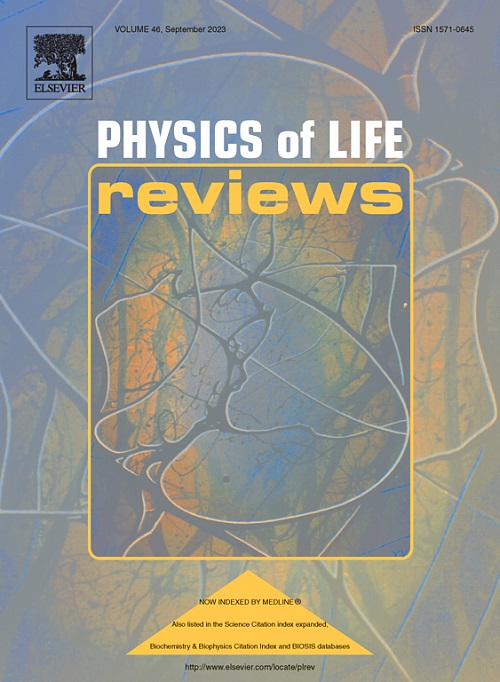“Homo informatio”
IF 14.3
1区 生物学
Q1 BIOLOGY
引用次数: 0
Abstract
A phylogenetic split ∼7.5 Ma (million years ago) separated paninan ancestors that were unlike today's chimpanzees, from homininan ancestors that were unlike Homo sapiens today; neither had evolved into their modern physical and behavioural forms. Those paninans gave rise to the mainly frugivorous woodland-dwelling chimpanzees (Pan troglodytes), whose multifemale-multimale troops have social hierarchies where prominent parts are played by promiscuous males whose female offspring have little choice after menarche but to seek sexual partners in other troops, hostility between troops notwithstanding, whilst male promiscuity is incompatible with paternal interest in their offspring, interest being provided mainly by mothers or female alloparents. Contrary to widespread conjecture that the social arrangements of Pan were those of primaeval homininans, it is proposed here that ∼4 Ma the nature of the mosaic landscapes (of grasslands and stands of trees) that were the habitat of australopithecine homininans, had 4 consequences that impinged on homininan evolution, differentiating it from that of woodland-dwelling paninans: (1) The diversity of whatever was available to eat was not the same in adjoining habitats of homininan social units, each of which may have been constrained by whatever mostly could be foraged, scavenged, eaten, or carried away, within perhaps a 2-hour walk; (2) Whatever was forageable, scavengeable, and edible within that distance likely was limited at any period of the year, so social units were increasingly omnivorous and necessarily small; (3) Smallness demanded cognitive ingenuity and transmissibility of existential information acquired by active inference generated by self-evidencing through enacted neuroethological behavioural responses, in line with the free energy principle, thanks to the cognitive broadening of homininan “zones of bounded surprisal” (ZBS) with respect to paninans' ZBS, both within each homininan “small-world” social unit and between nearby homininan units spreading out, in space and time, as budding very small-world information networks; (4) The existential continuity of small homininan social units depended on cooperation and sporadic collaboration between social units with mixed-sex philopatry (perhaps present ∼4 Ma among Australopithecus anamensis), behaviour which, together with (a) the generation of information within each unit that is enhanced by the intimate proximity to toddlers and children of older females and males in small mixed-sex social units, and (b) mixed-sex dispersal of sexually-active partners establishing mixed-sex social units at newly-formed localities nearby, was behaviour that maintained not only heterozygosity, but also, crucial cognitive awareness of kinship links favouring transmissibility of information and cooperation and collaboration (rather than hostility) between neighbouring social units, and was behaviour that represented evolutionary cognitive and social divergence from paninans. The vulnerability of small fragile social units implies there were hundreds of false dawns between ∼4 Ma and ∼40,000 BCE when even Homo neanderthalensis had vanished, leaving only our prehistoric Homo sapiens ancestors bearing "Homo informatio's" highly-evolved hierarchically mechanistic mind with its unequalled wide cognitive “zone of bounded surprisal” (ZBS) grounded in active inference in accord with the free energy principle.
大约750万年前的系统发育分裂将与今天的黑猩猩不同的猿人祖先与与今天的智人不同的人类祖先分开;它们都没有进化成现代的身体和行为形式。这些paninans产生了主要以水果为食的林地黑猩猩(Pan troglodytes),其多雌多雄的群体具有社会等级制度,其中突出的角色是滥交的雄性,它们的雌性后代在月经初潮后别无选择,只能在其他群体中寻找性伴侣,尽管群体之间存在敌意,而雄性的滥交与父亲对后代的兴趣是不相容的。兴趣主要由母亲或女性异体父母提供。与普遍的推测相反,潘人的社会安排是原始人类的社会安排,这里提出,大约4年前,作为南方古猿人类栖息地的马赛克景观(草原和树木)的性质对人类进化产生了4个影响,使其与居住在林地的潘人区分开来:(1)在人类社会单位相邻的栖息地中,可吃的东西的多样性是不一样的,每一个都可能受到大约2小时步行范围内可以觅食、拾取、食用或带走的东西的限制;(2)在这一距离内,任何可采、可食和可食用的东西在一年中的任何时期都可能是有限的,因此社会单位越来越杂食性,必然是小的;(3)“小”要求认知独创性和存在信息的可传递性,这些信息是通过通过制定的神经行为学行为反应产生的自证性主动推理获得的,符合自由能原理,这要归功于人类“有限惊奇区”(ZBS)的认知扩展,无论是在每个人类“小世界”社会单位内,还是在空间和时间上分布的邻近人类单位之间。正在萌芽的小世界信息网络;(4)小型人类社会单位的存在连续性依赖于具有混合性别哲学的社会单位之间的合作和零星合作(可能在南方古猿中存在~ 4 Ma),这种行为连同(a)在小型混合性别社会单位中,每个单位内的信息生成通过与幼儿和老年女性和男性的儿童的亲密接触而增强;(b)性活跃伴侣的混合性别分散在附近新形成的地方建立混合性别社会单位,这不仅是维持杂合性的行为,而且是对亲属关系的关键认知意识,有利于信息的传播,以及邻近社会单位之间的合作和协作(而不是敌意),这是代表进化认知和社会分化的行为。小而脆弱的社会单位的脆弱性意味着,在公元前4万年到公元前4万年之间,甚至尼安德特人都消失了,只有我们的史前智人祖先拥有“信息人”的高度进化的等级机械思维,其无与伦比的广泛认知“有限惊喜区”(ZBS)基于与自由能原理一致的主动推理。
本文章由计算机程序翻译,如有差异,请以英文原文为准。
求助全文
约1分钟内获得全文
求助全文
来源期刊

Physics of Life Reviews
生物-生物物理
CiteScore
20.30
自引率
14.50%
发文量
52
审稿时长
8 days
期刊介绍:
Physics of Life Reviews, published quarterly, is an international journal dedicated to review articles on the physics of living systems, complex phenomena in biological systems, and related fields including artificial life, robotics, mathematical bio-semiotics, and artificial intelligent systems. Serving as a unifying force across disciplines, the journal explores living systems comprehensively—from molecules to populations, genetics to mind, and artificial systems modeling these phenomena. Inviting reviews from actively engaged researchers, the journal seeks broad, critical, and accessible contributions that address recent progress and sometimes controversial accounts in the field.
 求助内容:
求助内容: 应助结果提醒方式:
应助结果提醒方式:


